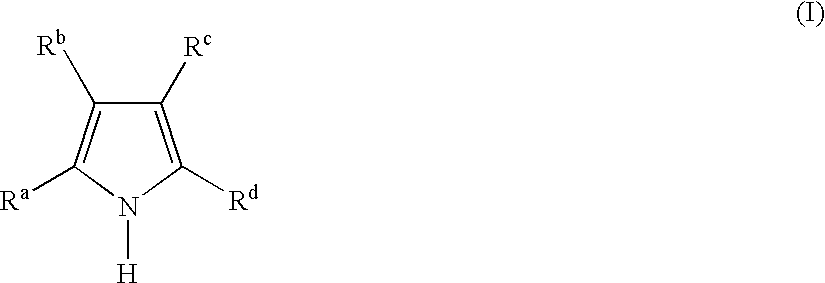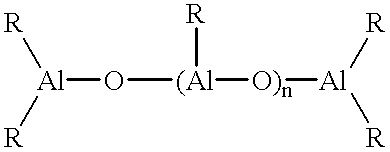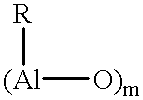Catalyst system for the polymerization of olefins
a technology of catalyst system and olefin, which is applied in the direction of catalyst activation/preparation, chemical/physical processes, group 3/13 element organic compounds, etc., can solve the problems of high reactivity of impurities (moisture, alcohols etc., easy flammability, etc., and it is not possible to isolate characterizable metallocene active species using mao
- Summary
- Abstract
- Description
- Claims
- Application Information
AI Technical Summary
Benefits of technology
Problems solved by technology
Method used
Image
Examples
example 2
Synthesis of N-[tris(2,3,4,5,6-pentafluorophenyl)borane]3-methyl-3H-indole (A-4) ##STR17##
A solution of 3-methylindole (98%, 0.92 g, MW=131.18, 6.87 mmol) in 10 mL of dichloromethane was added at room temperature under nitrogen atmosphere to a solution of B(C.sub.6 F.sub.5).sub.3 (BSC-382-4-0128, 99.4%, 3.53 g, MW=511.99, 6.85 mmol) in 15 mL of dichloromethane in a 50 mL Schlenk flask. Exothermicity was not observed. During the addition the color of the solution turned from light yellow to yellow. After 30 min stirring at room temperature, a .sup.1 H NMR analysis showed the presence of traces of unreacted 3-methylindole. Then 0.23 g (0.45 mmol) of tris(2,3,4,5,6-pentafluorophenyl)borane were added to complete the reaction. After overnight stirring, the solvent was removed in vacuo to give a white powder as product (yield 100%).
.sup.1 H NMR (CD.sub.2 Cl.sub.2, .delta., ppm): 1.61 (bs, 3H, CH.sub.3); 4.31 (bs, 1H, H3); 7.35-7.67 (m, 4H, Ar); 8.69 (d, 1H, J.sub.HF =5.3 Hz, H2).
.sup.1 H...
example 3
Synthesis of N-[tris(2,3,4,5,6-pentafluorophenyl)borane]2-methyl-3H-indole (A-3) ##STR18##
A solution of 2-methylindole (98%, 0.67 g, MW=131.18, 5.01 mmol) in 10 mL of dichloromethane was added at room temperature under nitrogen atmosphere to a solution of B(C.sub.6 F.sub.5).sub.3 (99.4%, 2.60 g, MW=511.99, 5.05 mmol) in 15 mL of dichloromethane in a 50 mL Schlenk flask. Exothermicity was not observed. During the addition the color of the solution turned from light orange to orange. A .sup.1 H NMR analysis in CD.sub.2 Cl.sub.2 showed quantitative conversion of the starting 2-methylindole after 1 h stirring at room temperature. The reaction mixture became a light pink suspension after 4 h stirring at room temperature. The stirring was continued overnight and then the suspension was filtered on a G3 frit. The residue on the frit was a white solid and resulted to be the desired product by .sup.1 H NMR analysis in C.sub.6 D.sub.6 (2.16 g, yield 67.0%). The final complex is not fully solu...
example 4
Synthesis of N-(trichloroborane)3H-indole (A-20) ##STR19##
A solution of indole (99%, 1.79 g, MW=117.15, 15.13 mmol) in 20 mL of dichloromethane was added in 5 min at -20.degree. C. under nitrogen atmosphere to a solution of BCl.sub.3 (1M in heptane, 15 mL, 15.0 mmol) in 15 mL of dichloromethane in a 100 mL Schlenk flask. At the end of the addition a yellow suspension was formed. The reaction mixture was kept at -20.degree. C. for 15 min and then allowed to warm up to room temperature. The color of the suspension turned slowly from yellow to pink. A .sup.1 H NMR analysis showed that the reaction was already complete after 1 h stirring at room temperature. After 4 h stirring at room temperature, the suspension was filtered on a G4 frit and the residue dried to give a pink powder, which resulted to be the desired product by .sup.1 H NMR analysis in CD.sub.2 Cl.sub.2 (2.79 g, yield 79.4%).
.sup.1 H NMR (CD.sub.2 Cl.sub.2, .delta., ppm): 4.27 (bs, 2H, H3, H3'); 7.42-7.81 (m, 3H, Ar); 8.37...
PUM
| Property | Measurement | Unit |
|---|---|---|
| temperature | aaaaa | aaaaa |
| temperature | aaaaa | aaaaa |
| temperature | aaaaa | aaaaa |
Abstract
Description
Claims
Application Information
 Login to View More
Login to View More - R&D
- Intellectual Property
- Life Sciences
- Materials
- Tech Scout
- Unparalleled Data Quality
- Higher Quality Content
- 60% Fewer Hallucinations
Browse by: Latest US Patents, China's latest patents, Technical Efficacy Thesaurus, Application Domain, Technology Topic, Popular Technical Reports.
© 2025 PatSnap. All rights reserved.Legal|Privacy policy|Modern Slavery Act Transparency Statement|Sitemap|About US| Contact US: help@patsnap.com



